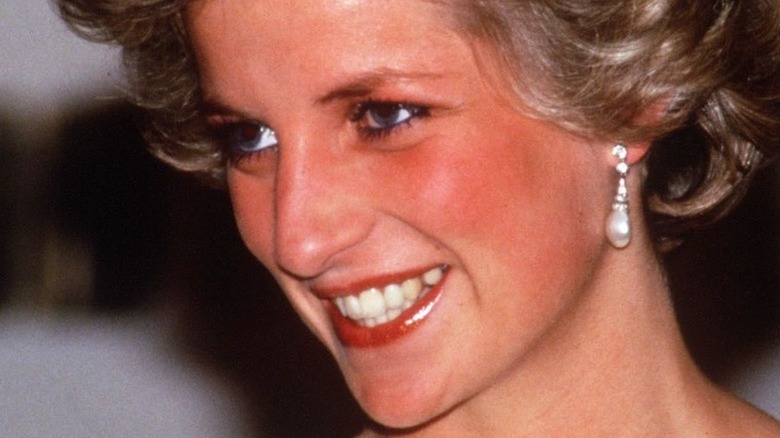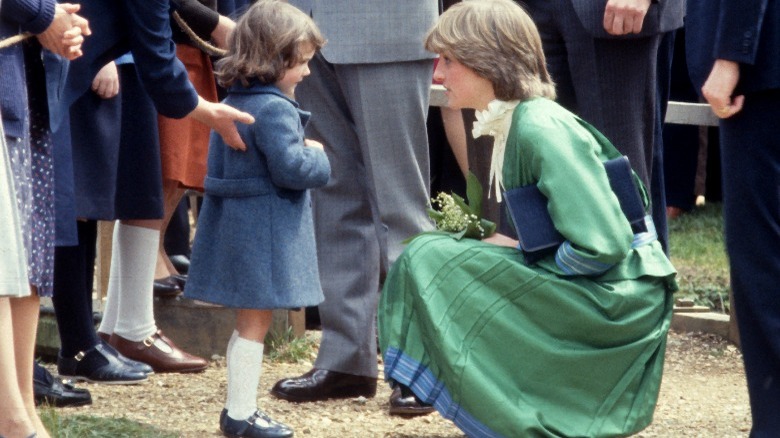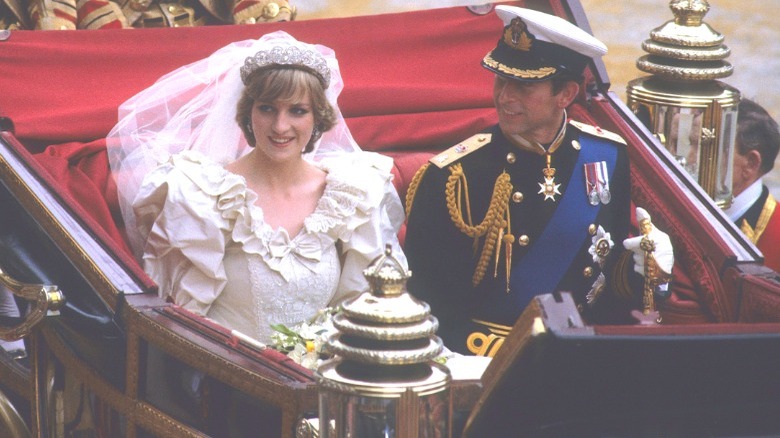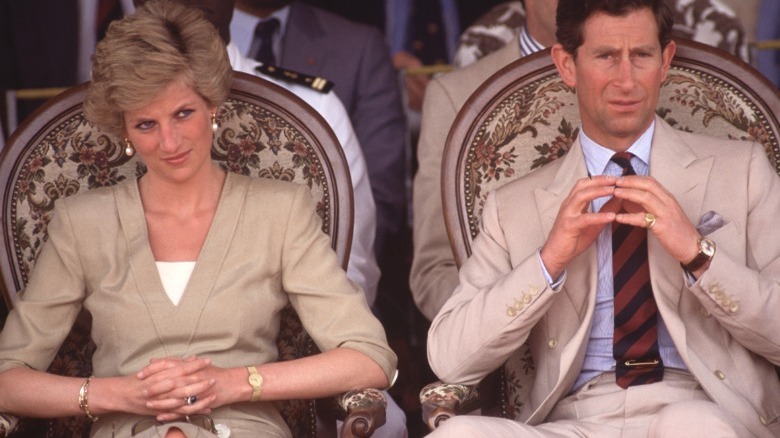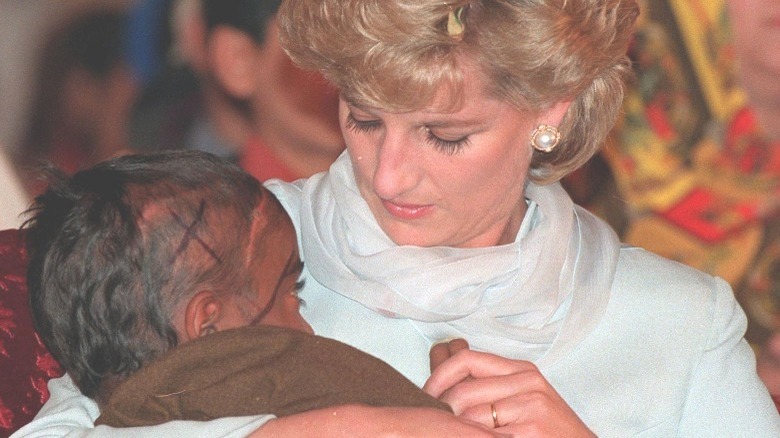Why Princess Diana's Former Bodyguard Says That She Changed People's Idea Of The Monarchy
The institution of monarchy has been the backbone of government in multiple countries across Europe for centuries. Over that time, various royal families developed different traditions and rules for how the family functions. These protocols are particularly important when it comes to how the royals are perceived by the public. One of the world's most famous monarchies, the British royal family, is extremely well known for its adherence to tradition. However, over the last few decades, a series of events changed the monarchy in the modern era.
Arguably one of the most beloved and dynamic people to ever be a part of the British royal family was Princess Diana. Her marriage to the newly crowned King Charles III raised a few eyebrows initially, but the media quickly became obsessed with them anyway. It became clear very early on that the new Princess of Wales was going to be a different kind of royal than most British subjects had previously seen.
Who Was Princess Diana?
Princess Diana was born Diana Spencer on July 1, 1961. Her father was Edward John Spencer, Viscount Althorp, and her mother was Frances Ruth Burke Roche, Viscountess Althorp (per Biography). She was the third of four children and was raised by her father following her parent's divorce. In 1975, she became Lady Diana Spencer when her father inherited the additional title of Earl of Spencer. Lady Diana also pursued her education and moved to London after finishing school in Switzerland. She then became an assistant at Young England Kindergarten because of her soft spot for children.
As a child, Diana was known for her shy nature, but she also had interests such as dancing and music. She also met her future husband, Charles, Prince of Wales, along with his younger brothers, Andrew and Edward. In 1977, Lady Diana and Prince Charles began a courtship that culminated in a proposal on February 6, 1981.
Marriage and Family Life
Lady Diana Spencer married Charles, Prince of Wales, on July 29, 1981, thus making her Diana, Princess of Wales. The couple exchanged vows in St. Paul's Cathedral in front of 2,500 guests, and the ceremony was televised across the world (per Biography). From her dress to her tiara and the carriage ride following the ceremony, the wedding of Charles and Diana was considered by many to be the wedding of the century.
Within a year of being married, the royal couple welcomed a baby boy, William Arthur Philip Louis, on June 21, 1982. Prince William then became the next heir to the British throne. Two years later, on September 15, 1984, Charles and Diana had another son, Henry Charles Albert David, more widely known as Prince Harry. In theory, this should have been the perfect family dynamic, a fairy tale if there ever was one. Unfortunately, all was not well in this branch of the British royal family tree, and tragedy was about to strike.
A Drama-Filled and Tumultuous Union
Though the fantastical wedding of Charles and Diana was the stuff many might dream of, their marriage was reportedly not a happy one. The couple's relationship was notoriously complicated for various reasons and was under constant scrutiny by the media. According to People, the "wedding of the century" almost didn't happen as Charles reportedly told his future bride that he didn't love her — the night before the ceremony. Diana went through with the wedding anyway, but their relationship over the next 15 years was rocky, to say the least.
Within five years, it was becoming more obvious that there was definitely trouble in paradise. Jealousy was a major issue in the relationship, and both Charles and Diana reportedly began having affairs around this time. Charles began seeing Camilla Parker Bowles and Diana reportedly began dating Major James Hewitt. Within a year, problems in the royal marriage hit the tabloids and were circulated far and wide. While the couple managed to make it to their 10-year anniversary, things fell apart soon after. The prince and princess separated in December 1992, and their divorce was finalized in 1996 (per Biography).
Charitable work
Despite her tumultuous and complicated marriage, Princess Diana became known the world over for something else — her compassionate heart. She became a familiar face in the world of philanthropy and worked with multiple charities across the globe. According to Harper's Bazaar, she raised awareness about the dangers of landmines and the devastating effects of leprosy. Additionally, she advocated tirelessly for both children and the homeless.
Arguably the act of charity she is best well known for is her advocacy for those with AIDS. Princess Diana opened the first AIDS hospital ward in Great Britain in 1987. Photographs of her shaking hands with HIV-positive patients without protection circulated around the world and challenged the theory that HIV/AIDS could be passed simply by touch. She almost single-handedly changed how the rest of the world saw and treated AIDS patients. Due to her kindness and empathy for others, Diana soon underwent another (less formal) name change when the people of the world dubbed her the "People's Princess."
A Tragic Death and An Enduring Legacy
Following her separation and divorce from Prince Charles, Princess Diana was living her best life, dedicating time to her charity work and raising her sons. However tragedy struck on August 31, 1997, when a car containing Princess Diana, her partner Dodi Fayed, and their driver crashed while trying to evade paparazzi (per Biography). The People's Princess succumbed to injuries she sustained in the crash and passed away at the age of 36.
In her short life, Princess Diana touched the lives of many around her and even managed to alter how people viewed those in the monarchy. People spoke with the princess' former bodyguard, who explained how she did this. Ken Wharfe explains that Diana's two sons, Prince William and Prince Harry, are the living legacy of their mother. The way that the princes carry themselves and interact with the public on a personal level is what he calls "classic Diana." Wharfe even goes as far as to say that their "style of operating" has completely transformed the monarchy and the public's perception of it. These days, the royal family interacts much more closely with their subjects, which, to some, makes them more personable than the generations before them.
Princess Diana's legacy lives on through her sons and through the Diana Princess of Wales Memorial Fund, which was started following her tragic death. It has since been divided between Prince William and Prince Harry as they continue to aid various charities in honor of their mother.
